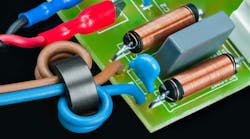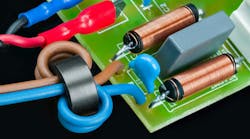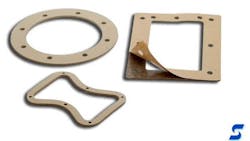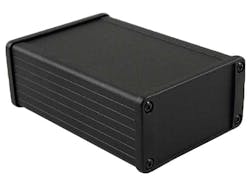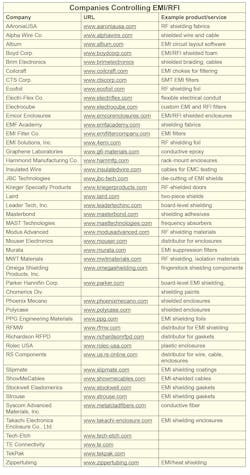Shielding Solutions Bring EM Isolation and Protection
What you’ll learn:
- Key to muzzling interference problems is understanding your system’s susceptibility.
- Higher frequencies lead to smaller circuits, which exacerbate EMI/RFI issues.
- Adding shielding as close as possible to EMI/RFI sources can reduce costs.
Shielding in any form can protect electronic equipment by enabling sensitive circuits and devices to function closely together amidst multiple electromagnetic (EM) fields. Whether to guard against EM interference (EMI) or radio-frequency interference (RFI), shielding comes in many shapes and sizes, from raw materials to finished enclosures.
Understanding the capabilities of available EMI/RFI shielding can help when searching for a solution to suppress EM and/or RF as electronic circuits shrink, with components and interconnections being designed closer together.
EMI and RFI refer to unwanted energy fields often far apart in frequency. Both forms of interference can degrade electrical performance, although at different frequencies. EMI tends to refer to noise sources at lower frequencies, such as power supplies and lines, while RFI usually occurs at higher frequencies, e.g., RF, microwave, and millimeter-wave frequencies. Interference can include fundamental and harmonic frequencies.
EMI or RFI can travel from a source to a component or device sensitive enough to receive it via conduction, radiation, capacitive coupling, or magnetic coupling. Conduction involves physical contact with conductors, radiation through free space, and capacitive or magnetic coupling between closely spaced signal lines and EM fields.
Interference can be continuous, such as from power lines or commercial broadcast stations, or intermittent, due to random interference like pulses or power surges. EMI may be narrowband or wideband, occupying more or less than the bandwidth of the component or system it affects.
Keep EMI and RFI Under Control
As use of electronic devices expands in daily life through mobile telephones, electric vehicles (EVs), and medical devices, proximity of so many electronic devices dictate an increased need for effective EMI/RFI shielding materials and methods. Achieving electromagnetic compatibility (EMC) for any application will require designing for EMI and RFI from the device level through the circuit and system stages of a design to address the interaction of so many closely placed potential EM emitters and receivers.
Growing use of mmWave frequency bands will also result in smaller signal wavelengths and smaller circuit dimensions, with components and devices closely spaced. Forward-thinking circuit layouts can minimize the shielding foils, gaskets, and even enclosures needed to prevent interference. But in many cases, additional shielding materials provide the most effective and practical means of curbing EMI and RFI disturbances.
By understanding the capabilities of the many shielding products currently available at the device, board, and system levels, EMI and RFI can be reduced to manageable and standards-acceptable levels that enable wired and wireless electronic devices to live together.
An EMI or RFI shielding solution may require blocking the flow of energy from a source or preventing a component’s reception of EMI or RFI. Surrounding a sensitive component on a printed circuit board (PCB) with a shielding structure known as a Faraday cage can stop the component from receiving external emissions and prevent the component from emitting EMI or RFI. Shielding solutions have been developed to surround components and devices on a surface-mount-technology (SMT) scale and as flexible materials. One such material is conductive foam filler, which can provide protection by absorbing unwanted EMI and RFI between PCBs in a system design.
>>Download the PDF of this article, and check out this TechXchange for similar articles and videos
Part of developing an effective EMI/RFI shielding solution is understanding the nature of an electronic design’s radiated or conducted EMI and RFI, as well as how susceptible the design is to EMI and RFI from other sources. Test equipment for understanding the EMI/RFI characteristics of a device under test (DUT) includes an EMI receiver, spectrum analyzer, near-field EM probes, and a line impedance stabilization network (LISN) to isolate a DUT from its own power supply (which could be the source of EMI or RFI).
Testing usually occurs in two different forms during an electronic product’s development cycle: as pre-compliance testing performed early during a DUT’s development, to discover any circuit or system EMI/RFI issues, and during the latter stages of a product’s development, in keeping with the regulatory compliance requirements for the product’s application area.
A design’s EMC can be determined according to regulations established by national and international standards organizations, such as the Federal Communications Commission (FCC) in the U.S., the European Union (EU) in Europe, and the International Special Committee on Radio Interference (CISPR) for global coverage.
Standards such as the FCC’s Part 15 regulations for most commercial electronic products and the FCC’s Part 18 rules for industrial-scientific-medical (ISM) electronic equipment are examples of standards which help establish compliance and compatibility among electronic devices in everyday life. The numbers of these electronic products, which are transmitting and receiving EM and RF energy, continue to rise, requiring efficient and effective shielding solutions whether as small as Faraday cages or as large as full equipment enclosures.
Shielding Encompasses Tiny Enclosures to Room-Sized Containers
Shielding solutions range from tiny, component-sized enclosures to room-sized housings, with the item or items to be shielded and design strategy determining the type of shielding to be used. Ongoing miniaturization of electronic designs in portable devices and greater use of higher wireless frequencies lead to more densely packed circuits in smaller designs and create more difficult EMI/RFI shielding challenges.
When PCBs tested for EMI and RFI exhibit problems, layout designers often consider changes in signal paths prior to adding shielding materials—even additional circuit layers and ground planes. However, failing to solve a small EMI/RFI problem can lead to a more expensive, enclosure-sized solution.
Among the shielding solutions are Faraday cages that make it possible to surround a component on six sides (including the PCB ground plane), grounding contacts, gaskets, conductive foam, and conductive adhesives such as epoxy. Shielding is typically implemented at the circuit, board, or enclosure level with costs minimized by adding shielding as close to the noise source as possible.
Shielding individual components and devices at the circuit level is essential when the radiation from that device may interfere with nearby components in the same circuit. The Faraday cage or shield has long been a means of EMI and RFI containment. It surrounds a component or device in an enclosure that prevents EM/RF energy from escaping the device or reaching it from outside the enclosure.
Leader Tech Inc. offers a wide range of board-level shielding solutions based on the Faraday cage, such as its CBS Series. Available in standard sizes from 0.5 × 0.5 in. to 12 × 24 in., the two-part EMI shields consist of a fence and removable cover (Fig. 1).
An Array of Shielding Materials
Laird, a DuPont Business produces microwave and millimeter-wave absorbing materials, including low-loss dielectric materials. Its conductive elastomers help block EMI and RFI over wide temperature ranges, while form-in-place gaskets meet the shielding needs of portable electronic products in plastic enclosures. They have been found effective in many automotive electronic applications, including for collision-avoidance radar systems operating at mmWave frequencies.
The company also features two-piece shields that simplify the repair of shielded components and devices without rebuilding major sections of a circuit board. Its Ecofoam material provides three-axis conductivity with conductive tape on one side for ease of forming odd-shaped gaskets.
Boyd is a supplier of EMI/RFI shielding foam such as its 5770 series conductive foam, which can be used to surround an emitter and absorb its excess conducted energy. MAST Technologies offers tuned frequency absorbers; thin, magnetically loaded sheet stock optimized for attenuation at discrete frequencies. Depending on frequency, they can provide as much as 20-dB attenuation of a component’s EM emissions. In addition, PPG Engineering Materials and its Cuming Microwave Corp.’s MicroGrid microwave absorber foils form thin EMI shields, including for anechoic chambers.
EMI shielding circuit- and board-level solutions come in many forms, including as adhesives and foams. Conductive epoxy such as G6-EPOXY from Graphene Laboratories, for example, can replace solder joints acting as unwanted antennas. It adheres to a variety of materials, including plastics, metals, glass, and ceramics, and is beneficial for heat-sensitive designs like those for medical devices. When thermal management is part of the problem, Master Bond Inc. provides thermally conductive, heat-resistant epoxy.
When sections of circuits must be isolated, EMI/RFI solutions are often best implemented as some form of gasket. EMI/RFI gaskets come in a wide range of composite materials, including the conductive silicone or rubber gaskets from Stockwell Elastomerics that can manage radiant and conductive EMI (Fig. 2). The gaskets are formulated to provide high EMI attenuation as well as environmental sealing, such as from rain, smoke, and dust, for several application areas ranging from residential and industrial to military environments.
Similarly, Zippertubing has fabricated a rubberized form of conductive plastic film with wide temperature range for EMI shielding that needs flexible gaskets.
Electronic leaks through signal paths often occur within cables and connectors, requiring the use of shielded cables and cable assemblies. For example, shielded cables from Alpha Wire surround cables for various applications with shielding foil or braids to prevent the reception or transmission from EM/RF energy from the cables.
Also on that front, ShowMeCables offers a variety of EMI-shielded cables and cable assemblies for fiber-optic, power, and RF/microwave interconnections.
Brim Electronics Inc. employs braiding on its EMI shielded and instrument-grade cables for high isolation even in dense circuit architectures. The firm’s 1110 series shielded braiding (Fig. 3), for instance, employs tinned copper conductors for grounding in vehicles to eliminate interference from ignition. The latest addition to the 1110 series is the model 1115 flat tinned copper braid; conductors are formed with annealed tinned copper to provide significant reduction of EMI and RFI even in automotive environments.
EMI/RFI shields provide protection for entire circuits and designs. When specific noise sources must be blocked, EMI/RFI filters can attenuate the flow of noise at fundamental and harmonic frequencies and help achieve electromagnetic compatibility (EMC) for a circuit or system without adding extensive shielding materials. EMI/RFI filters are available from a number of suppliers, including CTS Corp., Electrocube, EMI Filter Co., Murata, and TE Connectivity.
Shielded Enclosures Swallow EMI Emissions
When entire circuits or subsystems must be surrounded to prevent EM/RF leakage or exposure to nearby EM/RF energy fields, especially circuits that may contain unintentional antennas, they’re usually encased in a conductive enclosure. Such an enclosure typically includes a housing, lid, and conductive gasket. For example, the 1457-EMI Series enclosures from Hammond Manufacturing Ltd., available with wall-mounting flanges, provide EMI shielding with reliable environmental protection (Fig. 4).
Emcor Enclosures produces EMI/RFI shielded cabinets, cages, and enclosures such as its PROTECTOR server cabinets, which are also designed to provide data security. The enclosures feature horizontally split locking side panels for ease of access and cabinet designs with high ventilation rates (above 80%). Additional suppliers of EMI/RFI shielded enclosures include Phoenix Mecano, Polycase, and Takachi Electronics Enclosure Co. Ltd.
The importance of EMI/RFI shielding continues to rise due to the growing number of electronic devices in constant use. Challenges will be in providing adequate shielding for the rapidly shrinking dimensions of portable and mobile electronic devices, as well as developing effective but affordable shielding materials that fit the newest designs in many ways.
